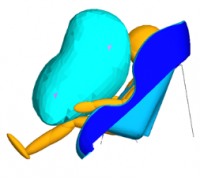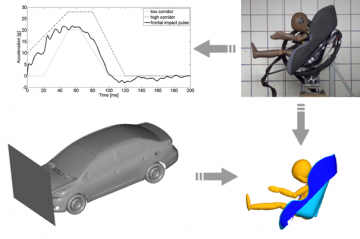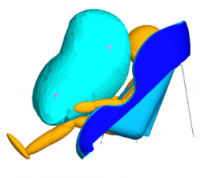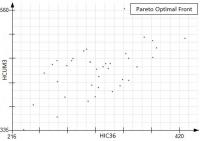Start » Badania » Projekty badawcze »
Reducing children's injuries in road accidents
Solutions are proposed to reduce the risk of serious injuries is the use of safety belts integrated with the child restraint system with pretensioners, load limiters and the airbag
Analysis of the possibility of reducing children's injuries during road accidents
Children transported by passenger cars require safety systems specially adapted to their needs due to anatomy, physiology and behavior different from adults. The proposed solution to reduce the risk of serious injuries is the use of safety belts integrated with the child restraint system with pretensioners, load limiters and the airbag. The purposes of the research:
• to identify real life positions in which children travel (experimental research),
• to assess the risk associated with these positions (numerical research),
• to limit overloads acting on the child’s body,
• to estimate the effectiveness of the proposed safety systems,
• to investigate statistically significant factors (statistical research),
• to optimize safety systems for children in order to find the best possible solutions.
The research was conducted under permission of the Ethics and Bioethics Committee. The precrash positions were identified in experimental research. The kinematic and injury criteria of the most important regions of the child’s body were crucial during optimizing child safety systems (about 20 % risk of an AIS3+ injury).
2187 numerical simulations were performed in one of the statistical plan. Seatbelt parameters had the greatest overall effect on injury responses. The slack in the CRS harness caused a significant increase of injury criteria values. Using airbag resulted in a decrease in normalized values of all injury indicators by approximately 40 %. As a result of the multi-criteria optimization, many solutions near optimal one called Pareto optimal solution were obtained. The scope of the obtained results is even over 90 % for the HIC36 indicator and about 70 % for the HCUM3 indicator (whereas in homologation tests we obtain only one value).
|
|
|
It was found that the use of properly adjusted to the individual needs of the child, child restraint system with pretensioners and load limiters reduces the likelihood of serious injuries and death as a result of the frontal collision more than 50 %. The future safety systems (e.g. used in autonomous cars) should cover most of the acceptable positions that a child can take in a properly used restraint system within the scope of road traffic regulations. This research and formulated recommendations may lead to increasing the effectiveness of future safety systems for children, improving methods of their testing and reducing the number of road traffic victims among the population of children in Poland. The team is working on the preparation of a series of patent applications to ensure:
• the child occupant safety by effective dissipation of collision energy,
• the improvement of the ergonomics of child restraint systems,
• the reduction of the risk of death, the minimization of the severity of injuries and long-term effects to the smallest possible level.
The research focused on semantic segmentation of road images in the off-road environment for autonomous robot navigation. It is possible to identify objects such as roads, trees, and obstacles using semantic segmentation. The state-of-the-art DeepLabv3 convolutional neural network (CNN) was used for image segmentation. The training of CNN networks requires a large image dataset. Creating a new real dataset requires not only new measurements but also requires time-consuming annotations. The research aim was to develop synthetic image generation methods based on 3D rendering to create a large image dataset and propose a training method based on the created dataset.
An example of a good diploma already defended is the following work: Michał Jasak, "Artificial intelligence of the chess playing robot", master thesis, 2021. The thesis aims to create an artificial intelligence-based system for real chess-playing robots. The system consists of the following parts:
• A computer vision system consists of a camera and a light source.
• CNN for detection of figures on board and assigns them into appropriate fields.
• Artificial intelligence to compute the best move possible in the current game state.
The thesis includes a detailed description of used convolution neural networks and reinforcement learning methods.
Relevant achievements
• Device for spine correction and measurement system: Wojciech Kaczmarek, Krzysztof Mianowski, Marcin Stańczuk, Grzegorz Kamiński, Rafał Rosołek – US Patent No US 9949884.
• Device for spine correction and measurement system (Urządzenie do korekcji kręgosłupa i system pomiarowy): Wojciech Kaczmarek, Krzysztof Mianowski, Marcin Stańczuk, Grzegorz Kamiński, Rafał Rosołek – Polish patent no: PL 229766.
• Device for children transpotation in vehicles (Urządzenie do przewozu dzieci w pojazdach): Michał Kowalik, Edyta Rola, Witold Rządkowski, Karol Suprynowicz – Polish patent no: PL 236856.






